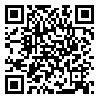Volume 9, Issue 3 (9-2020)
2020, 9(3): 7-12 |
Back to browse issues page
1- Dental Sciences Research Center, Department of Orthodontics, School of dentistry, Guilan University Of Medical Sciences, Rasht, Iran
2- Postgraduate Student of Orthodontics, Department of Orthodontics, School of dentistry, Guilan University of Medical Sciences, Rasht, Iran
3- Dentist
2- Postgraduate Student of Orthodontics, Department of Orthodontics, School of dentistry, Guilan University of Medical Sciences, Rasht, Iran
3- Dentist
Abstract: (779 Views)
Introduction: Malocclusion is a common oral disease that, in addition to damaging the functioning of the oral system and hygiene, can harm a person’s social relationships and mood by negatively affecting their beauty and self-esteem and reduce the quality of life. Many malocclusions, if detected, can be corrected at the right time by spending less time and money, which plays a significant role in the quality of life.
Materials and Methods:In this applied research, 76 students in the range of 12 to 14 years old (39 girls and 37 boys) were evaluated in four groups. The first group consisted of individuals with normal overjet and 3≤ mm anterior crowding. The second group consisted of less than 2 mm overjet and 3≤ mm anterior spacing. The third group has 6≤ mm overjet with crowding and1 ≥ mm spacing. The fourth group has a control group consisting of subjects with normal occlusion. To examine the effect of this malocclusions on quality of life, The Oral Health Related Quality of Life (OQLQ) questionnaire was used. For statically analyses Kolmogorov-Smirnov and Kruskal-Wallis test were used. The significance level in all tests was 0.05.
Results: The results showed that there was no statistically significant difference between the four groups in each domain (oral functioning, social aspect, dentofacial beauty and dentofacial beauty awareness). (p> 0.05).
Conclusion: Malocclusions such as anterior crowding, anterior spacing and increased overjet do not affect the quality of life of untreated 12-14 year old subjects.
Materials and Methods:In this applied research, 76 students in the range of 12 to 14 years old (39 girls and 37 boys) were evaluated in four groups. The first group consisted of individuals with normal overjet and 3≤ mm anterior crowding. The second group consisted of less than 2 mm overjet and 3≤ mm anterior spacing. The third group has 6≤ mm overjet with crowding and1 ≥ mm spacing. The fourth group has a control group consisting of subjects with normal occlusion. To examine the effect of this malocclusions on quality of life, The Oral Health Related Quality of Life (OQLQ) questionnaire was used. For statically analyses Kolmogorov-Smirnov and Kruskal-Wallis test were used. The significance level in all tests was 0.05.
Results: The results showed that there was no statistically significant difference between the four groups in each domain (oral functioning, social aspect, dentofacial beauty and dentofacial beauty awareness). (p> 0.05).
Conclusion: Malocclusions such as anterior crowding, anterior spacing and increased overjet do not affect the quality of life of untreated 12-14 year old subjects.
Type of Study: Original article |
Subject:
General
Received: 2020/09/25 | Accepted: 2020/10/5 | Published: 2020/10/5
Received: 2020/09/25 | Accepted: 2020/10/5 | Published: 2020/10/5
| Rights and permissions | |
 | This work is licensed under a Creative Commons Attribution-NonCommercial 4.0 International License. |




